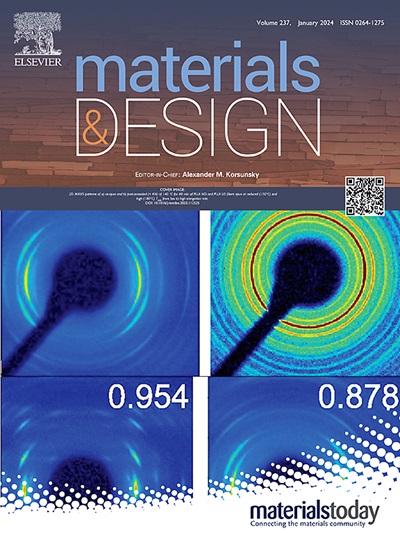Excellent mechanical properties of a novel double-diagonal reinforced mechanical metamaterial with tunable Poisson’s ratios inspired by deep-sea glass sponges
IF 7.6
2区 材料科学
Q1 MATERIALS SCIENCE, MULTIDISCIPLINARY
引用次数: 0
Abstract
In the realm of mechanical metamaterials, those exhibiting high strength and tunable properties were pivotal for advancing smart functionality applications. Inspired by the robust structure of deep-sea glass sponges, the double-diagonal reinforced metamaterial had been recognized for its exceptional mechanical properties. Here, this approach was refined by addressing a previously overlooked aspect, the thickness ratio of diagonal to square struts, and introduced a novel mechanical metamaterial. This innovation enabled the metamaterial to exhibit three distinct deformation patterns, facilitating a transition between negative, zero, and positive Poisson’s ratios, thereby achieving both high strength and sign-switchable Poisson’s ratio characteristics. Through a combination of experimental and numerical analyses, the regulatory mechanism was unraveled by which diagonal reinforcement influenced the metamaterial’s deformation behavior, energy absorption capacity, and Poisson’s ratio, culminating in the development of a programmable mechanical metamaterial. Theoretical investigations were conducted for both the elastic and plastic behaviors of the metamaterial, thoroughly examining the effects of geometric parameters on its mechanical performance. Moreover, compared with traditional diagonal-reinforced metamaterials, this design strategy demonstrated superior mechanical advantages. This comprehensive analysis not only highlighted the functional attributes of the bionic sponge metamaterial but also provided deeper insights into the mechanical mechanisms underlying diagonal reinforcement in metamaterials.

求助全文
约1分钟内获得全文
求助全文
来源期刊

Materials & Design
Engineering-Mechanical Engineering
CiteScore
14.30
自引率
7.10%
发文量
1028
审稿时长
85 days
期刊介绍:
Materials and Design is a multi-disciplinary journal that publishes original research reports, review articles, and express communications. The journal focuses on studying the structure and properties of inorganic and organic materials, advancements in synthesis, processing, characterization, and testing, the design of materials and engineering systems, and their applications in technology. It aims to bring together various aspects of materials science, engineering, physics, and chemistry.
The journal explores themes ranging from materials to design and aims to reveal the connections between natural and artificial materials, as well as experiment and modeling. Manuscripts submitted to Materials and Design should contain elements of discovery and surprise, as they often contribute new insights into the architecture and function of matter.
 求助内容:
求助内容: 应助结果提醒方式:
应助结果提醒方式:


